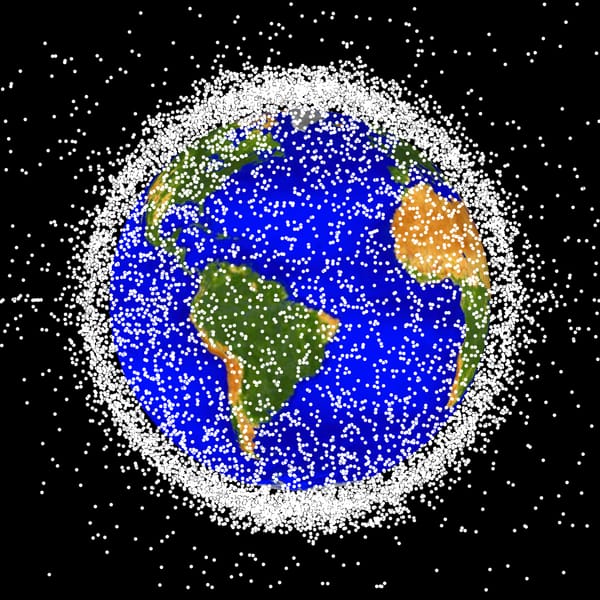Swarm: The Rise of Mega-Constellations and the Battle for Low Earth Orbit - Prologue
The Sky is Full
© Jay Allen 2025
Above Ukraine, the Future Arrived Early
In the opening days of Russia’s full-scale invasion of Ukraine in February 2022, the war appeared to follow a familiar script. Tanks breached borders. Missiles rained on cities. Airstrikes lit the skies over Kyiv. Yet high above the battlefield, invisible to the eye, and far beyond the reach of artillery, a quiet revolution was unfolding.
Ukraine’s communications infrastructure was disintegrating. Fibre-optic lines were severed. Cellular towers were jammed. Russian forces, leveraging sophisticated electronic warfare capabilities, were cutting off entire regions from command and control. Front-line Ukrainian units faced the very real prospect of operating in the dark, unable to call for reinforcements, unable to share coordinates, unable to coordinate their defence.
Then came the satellites.
On 26 February, just two days into the invasion, Ukraine’s digital minister, Mykhailo Fedorov, tweeted a direct appeal to Elon Musk:
“while you try to colonize Mars — Russia try to occupy Ukraine! While your rockets successfully land from space — Russian rockets attack Ukrainian civil people! We ask you to provide Ukraine with Starlink stations and to address sane Russians to stand.”
Within hours, Musk replied:
“Starlink service is now active in Ukraine. More terminals en route”
What followed was unlike anything in the history of modern warfare. Unmarked boxes began arriving through Polish border crossings. Starlink terminals, designed for consumer internet access in remote areas, were now being discreetly distributed to Ukrainian commanders, hospital staff, emergency services, drone units, and local officials.
They weren’t ruggedised. They weren’t protected by military-grade encryption. Many were powered by scavenged car batteries or hooked up to jerry-rigged solar panels. And yet, they worked. High-speed, resilient internet was beamed from hundreds of kilometres overhead, routed through a private constellation of satellites in low Earth orbit, Starlink.
These were not government assets. They hadn’t been requisitioned by NATO, nor authorised under any treaty. But within days, they were directly enabling Ukraine’s war effort: coordinating battlefield movements, guiding drone strikes, exposing war crimes, livestreaming the conflict in real time. In some cases, they were used to direct kamikaze drones behind Russian lines, a commercial system performing precision military functions.
The message was clear: low Earth orbit was no longer neutral.
For defence analysts and political leaders watching from afar, Starlink’s deployment in Ukraine was not just a tactical win. It was a doctrinal earthquake. For decades, space was considered the high ground, but also a sanctuary. Most satellites were strategically positioned, fragile, and far away in geostationary orbit, 36,000 km above Earth. They were expensive to build, slow to replace, and too valuable to target. Space was militarised, yes, but only in the most restrained, abstract sense.
Starlink changed that. It demonstrated that a commercially operated, distributed constellation of thousands of low-cost satellites could provide a battlefield advantage, doing so with speed, flexibility, and global reach. It functioned as a resilient communications layer and as a de facto extension of national power. Without formal agreements. Without government command. Without escalation, at least, not yet.
In response, the world took notice. Russian military strategists began debating, in open publications, whether commercial satellites used in war should be considered legitimate military targets. Chinese defence analysts issued warnings about “civilian infrastructure being drawn into conflict zones.” In Washington, quiet memos circulated. Deterrence, escalation, and attribution all would need to be rethought in light of this new domain.
And yet, Starlink was only the beginning. Amazon’s Project Kuiper plans to launch over 3,000 satellites. The European Union’s IRIS² initiative promises “sovereign connectivity” free from reliance on US systems. China’s Guowang and Hongyun mega-constellations are being framed not just as telecom services but as pillars of national strategic infrastructure. OneWeb, once a struggling startup, is now partially owned by the UK government and a key player in Western space policy.
All of these systems are branded as commercial. All promise peaceful, civilian utility. But all are capable of much more.
The echoes of this transformation reach back decades. This isn’t the first time the world has misunderstood what an orbit could do. On 4 October 1957, a polished aluminium sphere the size of a beach ball rose into the sky over Kazakhstan. It carried no weapons, posed no physical threat, and weighed less than 85 kilograms. Yet when Sputnik 1 completed its first orbit of Earth, panic swept Washington.
For the first time, the United States had to contend with the reality that a rival power could place objects above American soil, out of reach, out of sight, but not out of mind. The satellite’s signal was a political message, not a military strike. But it redefined space overnight as a domain of power, prestige, and vulnerability.
Today, we face another Sputnik moment. But this time, the sphere is not a lone satellite; it’s a swarm overhead.
This book tells the story of how space, once the province of superpower spectacle and scientific ambition, has become the scaffolding of modern society and the next contested zone of geopolitical confrontation. It charts the evolution from Cold War satellite diplomacy to the boom-and-bust cycle of the 1990s, when Iridium, Teledesic, and Globalstar each sought to build a global communications web in orbit, and failed. Billions were lost. The dream of a connected Earth from space was written off as a fantasy, too fragile and too costly to sustain.
But in the 2010s, that dream returned reborn not through governments, but through private capital, reusable rockets, and exponential advances in computing. SpaceX has proven that launch costs can plummet. Modular satellite manufacturing enabled mass deployment. Cloud computing and edge processing made orbital bandwidth more valuable than ever. And rising geopolitical tensions made secure, redundant, sovereign communications infrastructure not just desirable, but strategic.
A new space-industrial complex emerged: faster, leaner, and less transparent. What began as a race to connect the offline world became a scramble to dominate the orbital commons. What started as broadband infrastructure has morphed into a strategic layer of global control.
We’ll examine how those commercial incentives: speed, scale, global reach, have fused with national imperatives: deterrence, surveillance, control. It follows the companies, investors, generals, and policymakers who now view orbit as both an asset and a battlespace. And it explores the mounting risks that emerge from this convergence.
The dangers are multiplying. Every new satellite joins a crowded and fragile orbital environment. One accidental strike could trigger a chain reaction, a Kessler Syndrome rendering key orbital altitudes unusable for generations. Constellations are controlled from the ground, often through unclassified commercial protocols. Their signals can be jammed. Their networks can be hacked. In some cases, their satellites can be redirected or blinded without firing a shot.
As demonstrated in Ukraine, when a civilian constellation is used for military operations, it becomes a legitimate target. But who authorises that strike? What happens when attribution is murky, or when a kill disables systems used by dozens of nations? With so many satellites networked and AI-integrated, decisions are increasingly made by algorithms. Surveillance, targeting, and manoeuvring can occur at machine speed, faster than humans can intervene. In a crisis, misinterpretation could lead to escalation.
The governance challenges are equally profound. Today’s mega-constellations operate under fundamentally different models of control. Starlink and Kuiper emerge from Silicon Valley’s ethos of private innovation, wielding global reach with limited public oversight. China’s Guowang represents the opposite extreme: state-directed infrastructure designed as an instrument of national power from inception. Europe’s IRIS² attempts a hybrid approach, striking a balance between sovereignty concerns and commercial efficiency. This divergence in orbital governance models echoes the early space race of the Cold War, but with a crucial difference—the stakes now extend far beyond prestige. When national digital infrastructure relies on platforms controlled by foreign corporations or rival states, the boundaries between commercial convenience and strategic vulnerability become blurred. The question is no longer who can reach space first, but who controls the networks that increasingly govern life on Earth.
Somewhere between Silicon Valley disruption and great power competition, we crossed a threshold. We have placed tens of thousands of satellites into low Earth orbit. We connected them to nuclear command links, maritime fleets, agricultural systems, drone networks, emergency services, rural classrooms, and cloud infrastructures. We made them indispensable—and we did so without a global governance framework, without binding rules of engagement, and without consensus on who owns what or who’s allowed to shoot first.
In the past, sovereignty was defined by land, sea, and air. Today, it may be defined by latency, uptime, and orbital control. Above our heads, the swarm is growing faster than we can track, regulate, or defend. And with it emerges a new kind of power: networked, privatised, orbital.
And we built it without a playbook.





